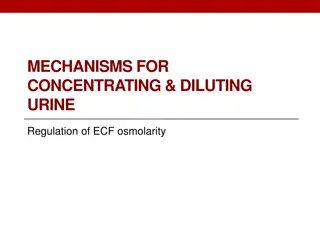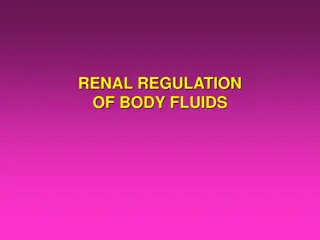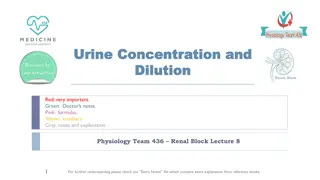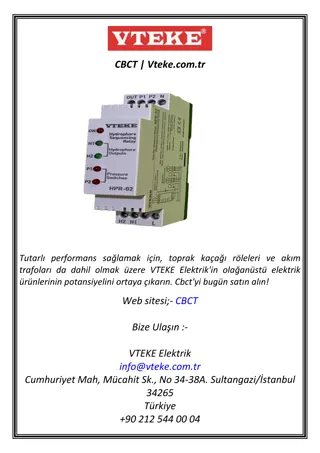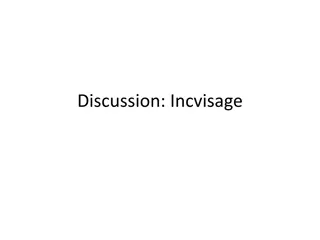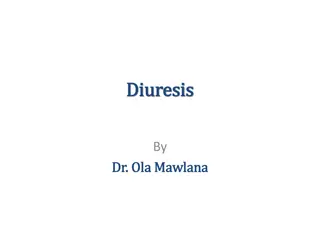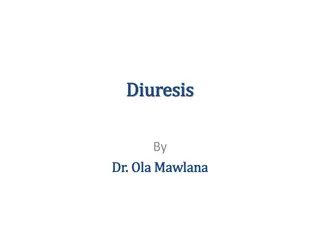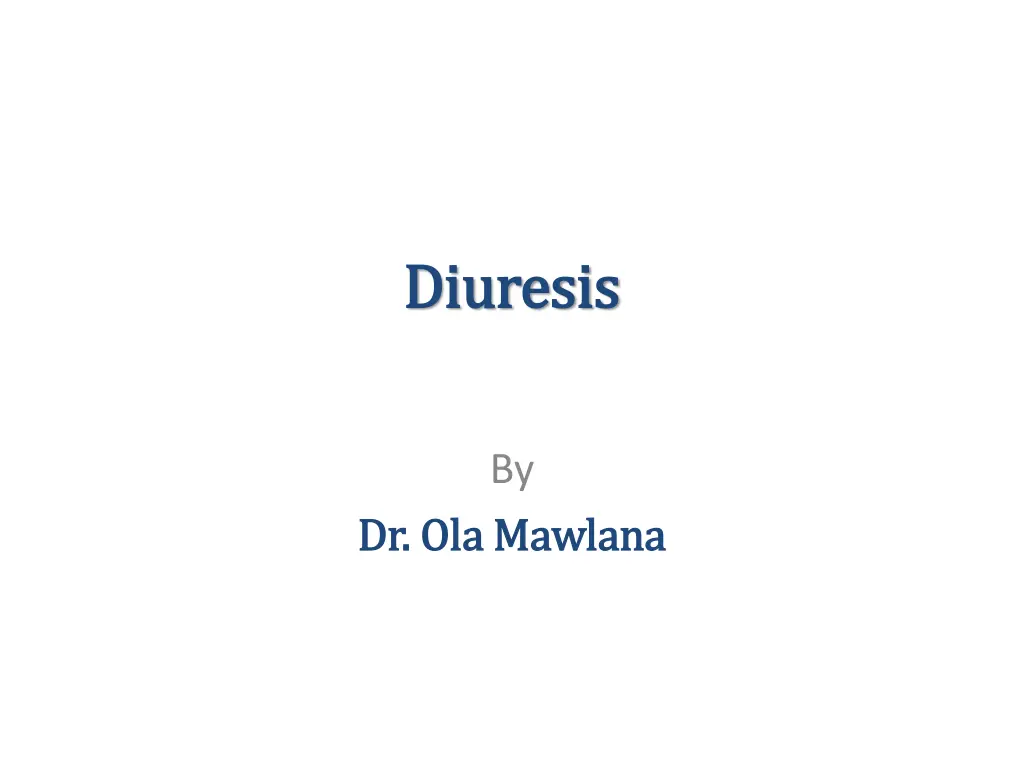
Understanding Diuresis and Kidney Function in Different Conditions
Explore the mechanisms of water and sodium balance in the body through the study of urine composition in fasting, water-drinking, saline-drinking, and diuretic-taking conditions. Learn about the impact on urine volume and color, as well as the regulatory processes involved in maintaining water balance.
Download Presentation

Please find below an Image/Link to download the presentation.
The content on the website is provided AS IS for your information and personal use only. It may not be sold, licensed, or shared on other websites without obtaining consent from the author. If you encounter any issues during the download, it is possible that the publisher has removed the file from their server.
You are allowed to download the files provided on this website for personal or commercial use, subject to the condition that they are used lawfully. All files are the property of their respective owners.
The content on the website is provided AS IS for your information and personal use only. It may not be sold, licensed, or shared on other websites without obtaining consent from the author.
E N D
Presentation Transcript
Diuresis Diuresis By Mawlana Dr. Ola Dr. Ola Mawlana
Objectives Objectives To compositions of urine excreted by 4 groups: ( fasting / drunk 1 L water/ drunk 1L saline / took 1 tab of lasix). To be able to discuss the mechanisms by which the body maintain the water and sodium homeostasis in the 4 different conditions. Definition and clinical applications of: - GFR ( Glomerular Filtration Rate) - CCr( Creatinine Clearance ) measure the volumes and determine the
Group 1 Group 1 - Emptied their bladders at 8:00 am and discarded the urine. - From 8:00 they are restricted to take any fluids and they are asked to provide various urine samples for analysis at: 10:00 am, 12:00 noon, 2:00 pm and 3:00 pm.
Group 1 Group 1 What will happen? Subsequent urine sample is lesser in volume and darker yellow in color that shows the kidneys try to conserve water in fasting state.
Deprive of H Deprive of H2 2O O Group Group 1 1 1 Plasma osmolarity 2 Stimulates Osmoreceptors in anterior hypothalamus 3 Thirst 3 ADH secretion from posterior pituitary H2O drinking 4 H2O permeability in late distal tubule and collecting duct 5a H2O reabsorption Plasma Plasma Osmolarity Osmolarity Toward Normal Toward Normal 5b Urine osmolarity and urine volume 6
Group Group 2 2 Emptied their bladder at 08:00 am and discarded the urine. At 10:00 am emptied their bladder again, but this time they measured its volume and provided a sample for analysis. This sample will be pre- experimental sample. Drank 1 liter of water immediately after providing the pre-experimental sample. Were then asked to empty their bladders and provide post-experimental samples every half an hour after drinking water until 3:00 pm.
Group Group 2 2
Group Group 2 2
m 1 Drink Drink 1 1L H L H2 2O O Group Group 2 2 Plasma Osmolarity 2 3 Inhibits osmoreceptors in anterior hypothalamus Thirst 3 ADH secretion from posterior pituitary H2O drinking 4 H2O permeability in late distal tubule and collecting duct 5a H2O reabsorption and excretion Plasma Plasma osmolarity osmolarity toward Normal toward Normal 5b Urine Osmolarity and urine volume 6
Group Group 3 3 Emptied their bladder at 7:00 am and discarded the urine. At 9:00 am emptied their bladder again, but this time they measured its volume and provided a sample for analysis. This sample will be pre-experimental sample. Drank 1 liter of 0.9% saline (isotonic saline) immediately after providing the pre-experimental sample. Were then asked to empty their bladders and provide post-experimental samples every hour after drinking saline until 3:00 pm.
I Isotonic saline sotonic saline 0.9 0.9% % Contains 154 mmol of NaCI, equivalent to 9 g of salt or 3.6 g of sodium. The sodium concentration of isotonic saline is equivalent to the normal sodium concentration of plasma water.
Group Group 3 3
Group Group 3 3
Isotonic Saline ( Isotonic Saline (0.9 1 1 liter 0.9%) %) Group 3 liter Volume of E.C.F. Osmolality same (as isotonic saline) Stretch on right atrium (volume receptors in right atrium) ANP (Atrial Natriuretic peptide) Na excretion by Kidneys
Group Group 4 4 Emptied their bladder at 8:00 am and discarded the urine. At 10:00 am emptied their bladder again, but this time they measured its volume and provided a sample for analysis. This sample will be pre- experimental sample. Swallowed a Lasix (Furosemide) tablet 40 mg with the help of 25 ml of water immediately after providing the pre-experimental sample. Were then asked to empty their bladders and provide post-experimental samples every hour after taking Lasix until 12:00 noon and then every half an hour until 3:00 pm.
What is What is Lasix Lasix? ? Furosemide is a loop diuretic used in the treatment of hypertension, congestive heart failure and edema. It inhibits the sodium-potassium-chloride co-transport system located within the ascending limb of the Loop of Henle.
Group Group 4 4
Group Group 4 4
1 1 tab of tab of Lasix Lasix ( (furosemide furosemide) ( with with 25 25ml of water ml of water ) (40 40mg) mg) Group Group 4 4 Action starts 1-2 hours and lasts for 4- 6 hours ( (1 1/ /2 2 life of life of furosemide furosemide is is 6 6hr) hr) Acts on thick ascending limb of loop of on thick ascending limb of loop of Henle Henle and blocks the Na-K-2Cl co- transport (called loop diuretic) Na excretion in urine and water excretion (osmotic drug)
Flow Rate (ALL) Flow Rate (ALL) 14 12 10 8 Lasix ml/min ml/min Control 6 Saline 4 Water only 2 0 0 2 4 6 8 10 12 14 Time(Hours) Time(Hours) 20
Na Excretion Na Excretion 900 800 700 600 umole/min umole/min 500 Water Control 400 Saline 300 Lasix 200 100 0 0 2 4 6 8 10 12 14 Time(Hours) Time(Hours) 21
Urine samples Urine samples e examination xamination Volume (measuring cylinder) Sodium photometry) and potassium concentration (flame PH (PH meter) Osmolality (Osmometer)
Measuring cylinder PH meter
Flame photometry Osmometer
The table that we fill out during these experiments The table that we fill out during these experiments
Calculation Calculation Total sodium excretion is obtained by applying following equation: Sodium excretion rate is obtained by applying the following equation:
Group Group 2 2
Group Group 3 3
Group Group 4 4
Group Group 4 4
GFR (Glomerular Filtration Rate) GFR (Glomerular Filtration Rate) Definition Definition: : Is the volume of fluid filtered from the renal glomerular capillaries into the Bowman's capsule per unit time. Urine Concentration X Urine Flow GFR GFR = Plasma Concentration According to the National Kidney Foundation, normal results range from 90 90 - - 120 120 ml/min/1.73 m2.
Abnormal Results of GFR Abnormal Results of GFR A GFR GFR < < 60 mL/min/1.73 m2 for 3 or more months chronic chronic kidney kidney disease disease. . A GFR GFR < < 15 mL/min/1.73 m2 kidney kidney failure failure. .
GFR (Glomerular Filtration Rate) GFR (Glomerular Filtration Rate) The test is recommended in: Diabetes Family history of kidney disease Frequent urinary tract infections Heart disease High blood pressure Urinary blockage
Creatinin Creatinin Clearance ( Clearance (C CCr Cr) ) Definition Definition: : The volume of blood plasma that is cleared of creatinine per unit time. U Ucr cr X X V V C CCr P PCr Cr = = Cr ( (U UCr sample (V) (V) = = urine flow rate ( (P PCr Cr) ) = = creatinine concentration in the collected urine Cr) ) = = plasma concentration
Creatinin Creatinin Clearance ( Clearance (C CCr Cr) ) Example: A person has a plasma creatinine concentration of 0.01 mg/ml and in 1 hour produces 60ml of urine with a creatinine concentration of 1.25 mg/mL. Normal Normal values Male: 97 to 137 ml/min. Female: 88 to 128 ml/min. values
Abnormal results for Abnormal results for C CCr Cr Abnormal results may indicate: Acute tubular necrosis Bladder outlet obstruction Congestive heart failure Dehydration End-stage kidney disease Glomerulonephritis Kidney failure Renal ischemia Renal outflow obstruction Shock
Thank You Thank You





